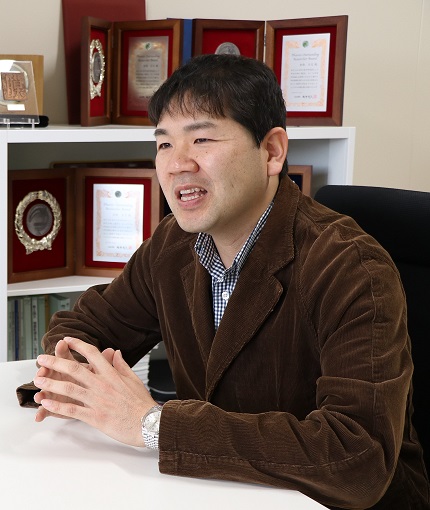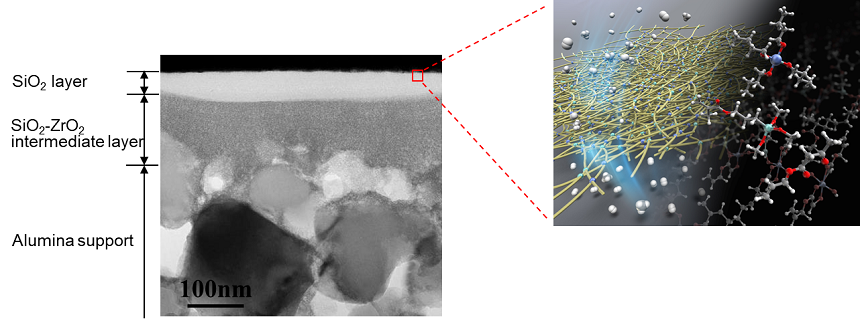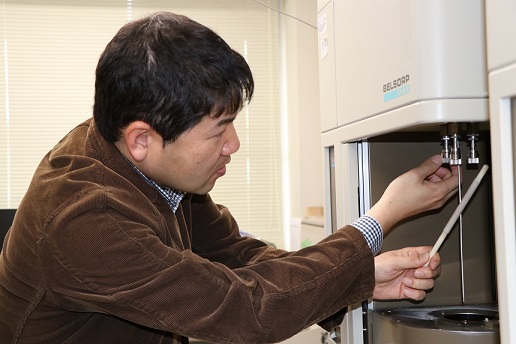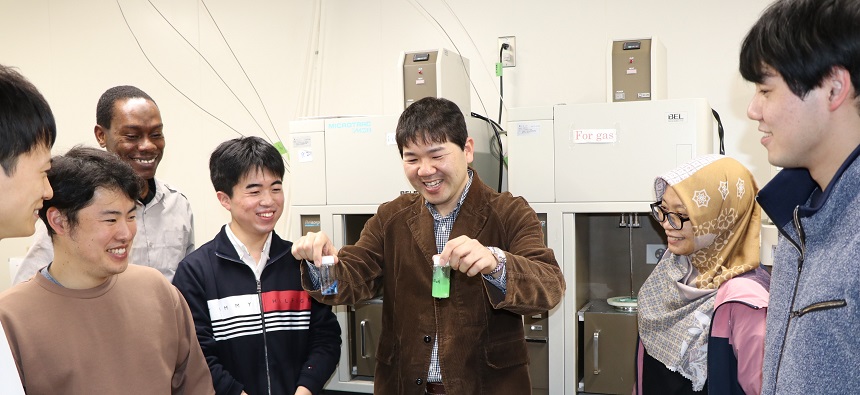On February 1, 2013, two new programs were established at Hiroshima University to foster talented individuals engaged in extraordinarily distinguished research activities: the "Distinguished Professors" (DP) program for senior faculty and the "Distinguished Researchers" (DR) program for junior faculty members.
A Conversation with Distinguished Researcher Dr. Masakoto Kanezashi

Could you introduce us to your research field?
I specialize in membrane science and technology. I am currently working on the development of novel porous materials for applications such as gas separation and liquid separation.
What is your educational background? How did you become interested in this particular field?
Both my father and grandfather were professors at Japanese universities, so I always wanted to follow in their footsteps and be a researcher. After graduating from Hiroshima University, I contacted several national projects to pursue my Master’s and PhD degrees. During these challenging yet fun times, I found about membrane separation and thought it was very interesting. After receiving my PhD from Hiroshima University, I was appointed as a postdoc researcher at Arizona State University in the USA from 2005 to 2007. Afterwards, I came back to Hiroshima University as an Assistant Professor and was later promoted to my current position.
On what type of membrane technology are you and your team working on?
We are mainly focusing on using amorphous silica, a kind of quartz glass, as a very thin coating layer to be placed over porous substrates to produce membranes with enhanced mechanical strength. These porous membranes are to be used in molecular separation systems.
Why is membrane science important, and how is this related to your research?
Separation processes, such as distillation, evaporation, and extraction, are ubiquitous in conventional chemical plants, including petrochemical plants. These processes typically consume huge amounts of energy for the purification of specific components. In contrast, membrane separation provides a more energy-efficient alternative. This is why membrane science and technology could help us reach the United Nation's Sustainable Development Goals (SDGs).
What are some key questions being asked by researchers in your field?
Many researchers, including myself and my team, recognize that not only the performance, but the cost and robustness of the developed membranes is critical for successful industrialization. In other words, we want membranes that not only have high permeation rate, selectivity, and stability, but that are also inexpensive and durable. Thus, the selection of materials and the optimization of the fabrication process are two important aspects for these purposes.
What major projects are you and your team working on right now?
There are actually many ongoing projects. One of them is the development of a gas separation membrane to separate hydrogen, carbon dioxide, and certain hydrocarbons. We are also working on porous membranes for water treatment.

Porous membranes can be used as molecular sieves tailored for the separation of specific compounds from liquids or gases. They represent an energy-efficient alternative to conventional separation processes commonly used in the industry. (Figure credits: Dr. Kanezashi of Hiroshima University)
What are some key challenges?
Amorphous silica has pores with a size of 0.3–0.4 nm, so we need to tailor the network’s pore size depending on the separation system we are aiming for. This is especially challenging when we want to separate molecules that are almost exactly the same size, such as propylene and propane. They differ in size by less than 0.04 nm and also have similar weights and absorption properties. To tackle such challenges, it is essential to better understand how the target molecules move through the membranes.
How feasible do you think commercialization of membrane technology is?
Many organic polymer membranes are already commercialized for the desalination of seawater, as well as zeolite crystal membranes for the dehydration of alcohol. While microporous silica membranes haven’t yet seen any industrial applications, this is because they are a recently developed family of materials that were not previously investigated as tools for molecular separation.

What have you found particularly interesting and rewarding about your research?
Research is always challenging because one is trying to achieve something no one else could do before. I find this very stimulating. In addition, I am in charge of several students, including PhD candidates, Master’s students, and Bachelor’s students. Our abilities are different, but we all share a common target and strive towards the same goal as one big team.
What research themes are you interested in exploring in the future?
The final goal of my research is to achieve the application of our membranes in industrial settings, for which robustness and cost are important. Thus, my research will focus on two large topics. First, making high-performance membranes. Then, lowering their fabrication costs to make them economically feasible. Only then will our efforts help us reach the SDGs for future societies.
What are some specific challenges that researchers in academia have to go through in current times?
Researcher in academia are also educators. My students are my responsibility, and I have to supervise them and help them set a good research topic so they can get their degree. This means that I have to stay very up-to-date and constantly think about new research topics.
Do you have any advice for young students or researchers?
All my students are very diligent, but sometimes, they're afraid of failure. Always try and challenge this fear; even if you fail, you will come out of it strong and learn something .

What are some things you enjoy outside of work?
I love fishing. I have three children, and one of my friends has a ship in Seto Inland Sea, which is close to Hiroshima. I like taking my kids fishing and camping in the islands there.

 Home
Home